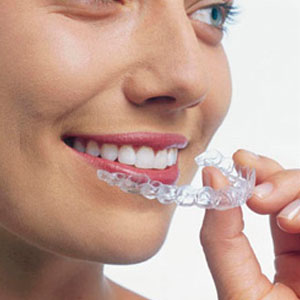<p>If you hate traditional braces, you’re not alone. After all, they look bad, they hurt, they can be nearly impossible to keep clean (meaning they can turn into a haven for tooth decay and gum infections), and they have a bunch of wires that can dislodge and cause you even more pain!<br />
But what do you do if you need a cosmetic dental straightening or if you have structural issues that need to be fixed? Are you stuck having a mouth full of metal?<br />
No way! These days, you have a choice – you can opt for Invisalign.<br />
What is it?<br />
Invisalign is a state-of-the-art orthodontic tool that’s made out of special polymer – meaning it’s a whole lot more flexible than those metal “railroad tracks” you could have in your mouth. And, Invisalign is shaped completely differently.<br />
It looks similar to a plastic retainer, with the only difference being that Invisalign doesn’t have a plate that rests up against the roof of your mouth. Instead, these aligners are U-shaped and slide right over your teeth.<br />
And, because they slide on and off, it’s much easier to keep your teeth clean!<br />
Best of all, though, Invisalign is completely transparent – so you won’t have to worry about people staring at a mouth full of metal instead of looking at YOU.<br />
Even though they look totally different, Invisalign’s aligners can give you the same straight smile that traditional braces can. Luckily, though, they don’t come with all of the same pain that traditional braces do! And, since there’s no wires involved, you don’t have to worry about anything coming undone and hurting the inside of your mouth.<br />
Like traditional braces, Invisalign’s aligners will have to be adjusted on a regular basis (usually about every two weeks). However, instead of going to the orthodontist’s office and having him tighten everything, your orthodontist will use a special computer to analyse your teeth’s progress. Then, he’ll give you a new set of aligners that were designed by the computer’s virtual treatment plan.<br />
In some cases, you may have to combine Invisalign with traditional braces. If you have a certain malocclusion (or, a certain misalignment), you may need to wear linguinial braces on your back teeth. Luckily, though, they’ll be so far back in your mouth that no one will notice them!<br />
See? It IS possible to have a straighter, healthier smile without all of the pain and complications that traditional braces can bring!<br />
Joanne Lemke is a final year creative writing student at UOW, who is looking to break into the corporate copywriting space once she graduates and hopefully go on to eventually some day write a book around her other passions, namely beauty, cooking and travel.</p>

The Ins And Outs Of Invisalign Invisible Braces
